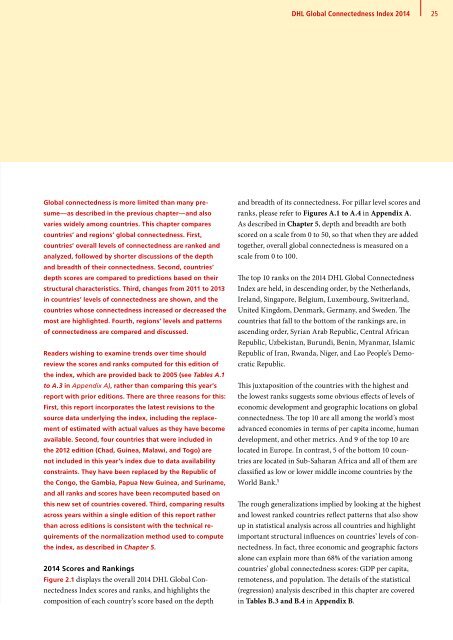DHL Global Connectedness Index 2014
DHL Global Connectedness Index 2014
DHL Global Connectedness Index 2014
- No tags were found...
You also want an ePaper? Increase the reach of your titles
YUMPU automatically turns print PDFs into web optimized ePapers that Google loves.
<strong>DHL</strong> <strong>Global</strong> <strong>Connectedness</strong> <strong>Index</strong> <strong>2014</strong><br />
25<br />
<strong>Global</strong> connectedness is more limited than many presume—as<br />
described in the previous chapter—and also<br />
varies widely among countries. This chapter compares<br />
countries’ and regions’ global connectedness. First,<br />
countries’ overall levels of connectedness are ranked and<br />
analyzed, followed by shorter discussions of the depth<br />
and breadth of their connectedness. Second, countries’<br />
depth scores are compared to predictions based on their<br />
structural characteristics. Third, changes from 2011 to 2013<br />
in countries’ levels of connectedness are shown, and the<br />
countries whose connectedness increased or decreased the<br />
most are highlighted. Fourth, regions’ levels and patterns<br />
of connectedness are compared and discussed.<br />
Readers wishing to examine trends over time should<br />
review the scores and ranks computed for this edition of<br />
the index, which are provided back to 2005 (see Tables A.1<br />
to A.3 in Appendix A), rather than comparing this year’s<br />
report with prior editions. There are three reasons for this:<br />
First, this report incorporates the latest revisions to the<br />
source data underlying the index, including the replacement<br />
of estimated with actual values as they have become<br />
available. Second, four countries that were included in<br />
the 2012 edition (Chad, Guinea, Malawi, and Togo) are<br />
not included in this year’s index due to data availability<br />
constraints. They have been replaced by the Republic of<br />
the Congo, the Gambia, Papua New Guinea, and Suriname,<br />
and all ranks and scores have been recomputed based on<br />
this new set of countries covered. Third, comparing results<br />
across years within a single edition of this report rather<br />
than across editions is consistent with the technical requirements<br />
of the normalization method used to compute<br />
the index, as described in Chapter 5.<br />
<strong>2014</strong> Scores and Rankings<br />
Figure 2.1 displays the overall <strong>2014</strong> <strong>DHL</strong> <strong>Global</strong> <strong>Connectedness</strong><br />
<strong>Index</strong> scores and ranks, and highlights the<br />
composition of each country’s score based on the depth<br />
and breadth of its connectedness. For pillar level scores and<br />
ranks, please refer to Figures A.1 to A.4 in Appendix A.<br />
As described in Chapter 5, depth and breadth are both<br />
scored on a scale from 0 to 50, so that when they are added<br />
together, overall global connectedness is measured on a<br />
scale from 0 to 100.<br />
The top 10 ranks on the <strong>2014</strong> <strong>DHL</strong> <strong>Global</strong> <strong>Connectedness</strong><br />
<strong>Index</strong> are held, in descending order, by the Netherlands,<br />
Ireland, Singapore, Belgium, Luxembourg, Switzerland,<br />
United Kingdom, Denmark, Germany, and Sweden. The<br />
countries that fall to the bottom of the rankings are, in<br />
ascending order, Syrian Arab Republic, Central African<br />
Republic, Uzbekistan, Burundi, Benin, Myanmar, Islamic<br />
Republic of Iran, Rwanda, Niger, and Lao People’s Democratic<br />
Republic.<br />
This juxtaposition of the countries with the highest and<br />
the lowest ranks suggests some obvious effects of levels of<br />
economic development and geographic locations on global<br />
connectedness. The top 10 are all among the world’s most<br />
advanced economies in terms of per capita income, human<br />
development, and other metrics. And 9 of the top 10 are<br />
located in Europe. In contrast, 5 of the bottom 10 countries<br />
are located in Sub-Saharan Africa and all of them are<br />
classified as low or lower middle income countries by the<br />
World Bank. 1<br />
The rough generalizations implied by looking at the highest<br />
and lowest ranked countries reflect patterns that also show<br />
up in statistical analysis across all countries and highlight<br />
important structural influences on countries’ levels of connectedness.<br />
In fact, three economic and geographic factors<br />
alone can explain more than 68% of the variation among<br />
countries’ global connectedness scores: GDP per capita,<br />
remoteness, and population. The details of the statistical<br />
(regression) analysis described in this chapter are covered<br />
in Tables B.3 and B.4 in Appendix B.





